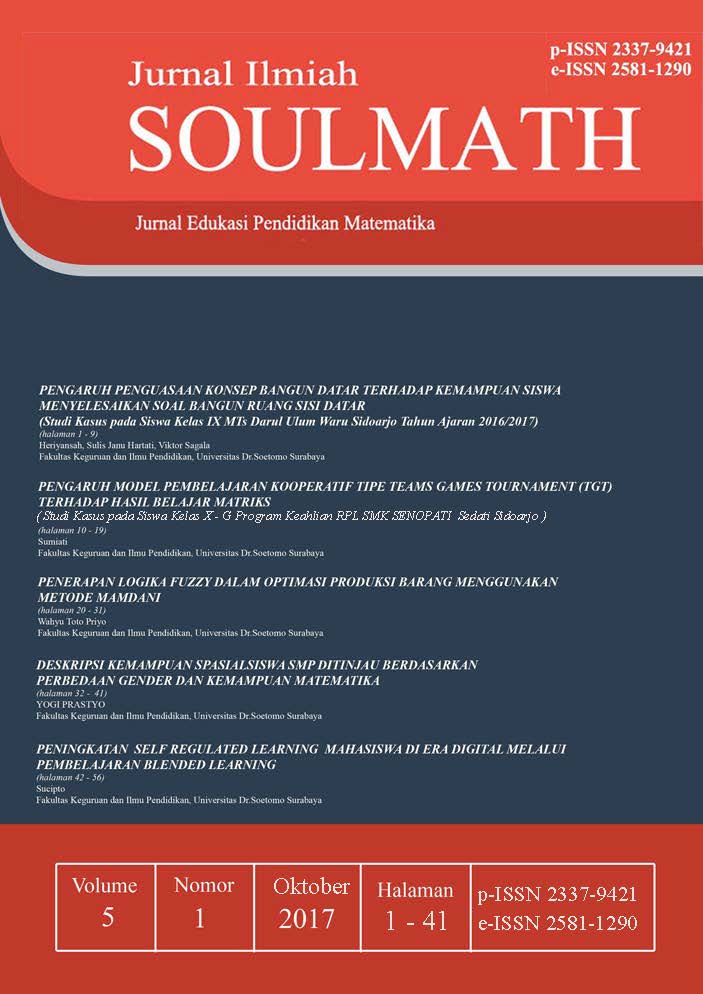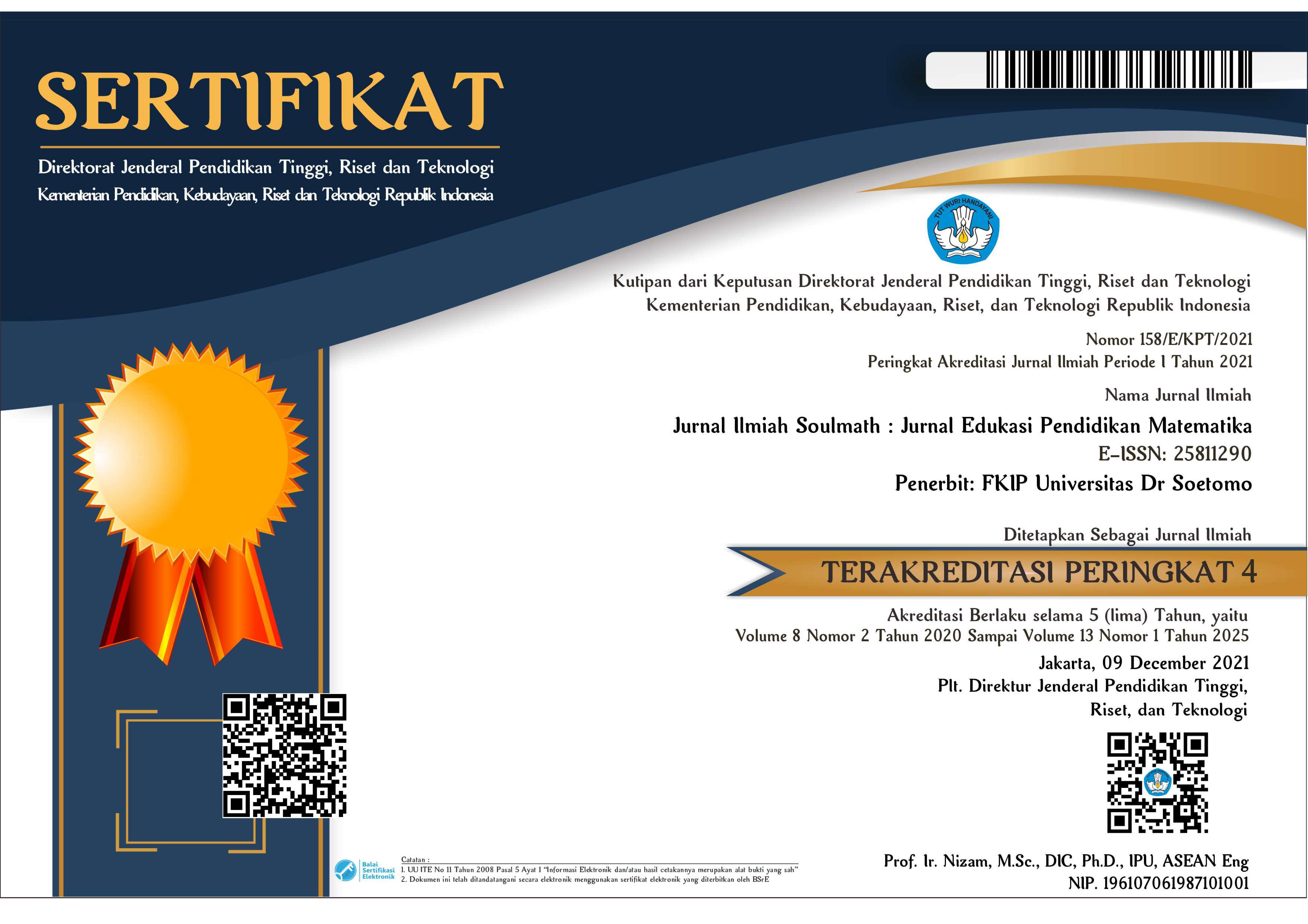PENINGKATAN SELF REGULATED LEARNING MAHASISWA DI ERA DIGITAL MELALUI PEMBELAJARAN BLENDED LEARNING
 Abstract views: 1683
,
Abstract views: 1683
,
 PDF (Bahasa Indonesia) downloads: 1742
PDF (Bahasa Indonesia) downloads: 1742
Abstract
Some students have not shown the ability to regulate themselves (self regulated learning) about how to learn. This is part of the impact of conventional learning. Blended learning is a learning model that is widely developed in college. This model provides opportunities for students to learn actively by self-regulation, self-control, self-motivation, and develop self-confidence, and choose or manage their own learning environment to support the effectiveness of learning. This study is based on literature review. Based on some empirical studies, it is concluded that the application of this model can improve self regulated learning learners.
Â
Keywords: blended learning, self regulated learning, conventional learning
Downloads
References
[2] Bersin, J. 2004. The Blended Learning Book Best Practices, Proven Methodologies and Lesson Learned. San Fransisco : John Weley.
[3] Chambers, M. 1999. The Efficacy And Ethics Of Using Digital Multimedia For Educational Purposes. In A. Tait & R. Mills (Eds.), The convergence of distance and conventional education: Patterns of flexibility for the individual learner (pp. 5-16). New York, NY: Routledge
[4] Dettori, Giuliana, Donatella Persico. 2007. Supporting Self-Regulated Learning in a Blended Course. Workshop on Blended Learning 2007, Edinburgh, United Kingdom., Blended Learning, pp. 174-185, Pearson.
[5] Donnelly, R. 2010. Harmonizing technology with interaction in blended problem-based learning. Computers & Education. 54 (2): 350-359.
[6] Dziuban, C., Hartman, J., Juge, F., Moskal, P., & Sorg, S. 2006. Blended learning enters the mainstream. In C. J. Bonk & C. R. Graham (Eds.), Handbook of blended learning:Global perspectives,local designs (pp. 195-208).San Francisco,CA: Pfeiffer.
[7] Dziuban, C., & Moskal, P. 2013. Distributed learning impact evaluation. http://cdl. ucf.edu /research/rite/dl-impact-evaluation.
[8] Ellen, D.W. & E.S. Anich. 2005. The Other Blended Learning A Classroom - Centered Approach. San Francisco: Pfeiffer.
[9] Graham, C. R. 2006. Blended Learning Systems: Definition, Current Trends, And Future Directions. In C.J. Bonk & C. R. Graham (Eds.), Handbook of blended learning: Global perspectives, local designs (pp. 3- 21). San Francisco, CA: Pfeiffer.
[10] Hara, N., & Kling, R. 1999. Students' frustrations with a web-based distance education course. First Monday, 4 (12). http://www.firstmonday.org/article/view/ 710/620.
[11] Harris, P., Connolly, J., & Feeney, L. 2009. Blended learning: overview and recommendations for successful implementation. Industrial and Commercial Training. 41 (3): 155-163.
[12] Hidayat, W. 2014. Pengguna Internet Indonesia Nomor Enam Dunia. http://tekno.kompas.com/read/2014/11/24/07430087.
[13] Hurlock, E. B. 1990. Psikologi Perkembangan. Jakarta: Erlangga.
[14] Isa, Y. 2015. Pengembangan model blended learning mata kuliah perencanaan teknologi pembelajaran, teknologi informasi dan komunikasi. Jurnal Teknologi Pendidikan . 17 (2): 73-83.
[15] Johnson, J. 2002. Reflections On Teaching A Large Enrollment Course Using A Hybrid Format. Teaching with Technology Today, 8 (6). http://www. uwsa.edu/ttt/articles/jjohnson.htm
[16] Kerlin, B. A. 1992. Cognitive Engagemant Style Self-Regulated Learning and Cooperative Learning.
[17] King, K. P. 2002. Identifying success in online teacher education and professional development. The Internet and Higher Education, 5 (3): 231-246.
[18] Lowry, C. M. 2000. Supporting and Facilitating Self-Directed Learning. ERIC Digest No 93,1989-00-00
[19] Lord, G. & Lomicka. 2005. Blended Learning in Teacher Education. An Investigation of Clasroom Community Across Media. Comtemporary Issues in Technology and Teacher Education, One way to Make It Effective. http://www.techknowlogia.org. Diakses 9 September 2005
[20] Lynch, R. & Dembo, M. 2004. The Relation-ship between Self Regulation and Online Learning in a Blended Learning Context. International Review of Research in Open and Distance Learning, (on line), 5 (2): 1- 16, http:// www.irrodl.org/index.php/irrodl/article/view/189/799), diakses tanggal 6 Januari 2012.
[21] Mason, R., Rennie, F. (2006). E-learning: The key concepts. Abingdon, UK: Routledge.
[22] Mitchell, A., & Honore, S. (2007). Criteria for successful blended learning. Industrial and Commercial Training. 39 (3): 143-149.
[23] Mitchell, A., & Honore, S. 2007. Criteria for successful blended learning. Industrial and Commercial Training. 39 (3): 143-149.
[24] Mustaji, Karwanto, U. Dewi, N. Khotimah. 2014. Pemberdayaan Mahasiswa Untuk Berpikir Kritis, Kreatif, Dan Kolaboratif Melalui Pengembangan Perangkat Pembelajaran Kolaborasi. Fakultas Ilmu Pendidikan, Universitas Negeri Surabaya
[25] Novitayati, R. 2013. Pengaruh Metode Blended Learning dan Self Regulated Learning Terhadap Hasil Belajar Kognitif IPS. Jurnal Penelitian Kependidikan No. 1 April 2013: 48 - 57.
[26] Oliver, M., & Trigwell, K. 2005. Can "blended learning" be redeemed? E-Learning. 2 (1): 17-26.
[27] Orhan. 2007. Applying Self Regulated Learn-ing Strategis in a Blended Learning Instruction. World Applied Science Journal, 2(4): 290-398. (Online), (http://www.idosi.org/wasj/wasj2(4)/19.pdf, diakses tanggal 14 Juli 2017.
[28] Papalia, Diane E. 2002. Adult Development and Aging, Second Edition. New York: Mc.Graw Hill.
[29] Poon, J. 2013. Blended Learning: An Institutional Approach For Enhancing Students' Learning Experiences. Australia: Merlot Journal Online Learning And Teaching. 9 (2): Juni 2013.
[30] Rusman, D. Kurniawan, C. Riyana. 2012. Pembelajaran Berbasis Teknologi Informasi dan Komunikasi. Jakarta: PT RajaGrafindo Persada.
[31] Shunck, D.H., & B.J Zimmerman. 1998. Introduction to the Self Regulated Learning (SRL) Cycle.
[33] Singh, H. 2003. Building effective blended learning programs. Educational Technology. 43 (6): 51-54.
[34] Sloman, M. 2007. Making sense of blended learning. Industrial and Commercial Training. 39 (6): 315-318.
[35] Stewart. J. M. (2002). A blended e-learning approach to intercultural training. Industrial and Commercial Training. 34 (7): 269-271.
[36] Sutisna, A. 2016. Pengembangan model pembelajaran blended learning pada pendidikan kesetaraan program paket c dalam meningkatkan kemandirian belajar. UNJ, Jakarta. Jurnal Teknologi Pendidikan. 18 (3): Desember 2016.
[37] Tabor, S. W. 2007. Narrowing the distance: Implementing a hybrid learning model for information security education. Quarterly Review of Distance Education. 8 (1): 47- 57.
[38] Thorn, K. 2003. Blended Learning. How to Integrate Online and Tradicional Learning, London: Kogen Page.
[39] Ting, K. & M. Chao. 2013. The application of self-regulated strategies to blended learning. Canadian center of science and education. English Language Teaching. 6 (7): 1916 - 4742.
[40] Tsai, C., Shen, P. & Tsai, M. 2011. Develop-ing an appropriate design of blended learning with web-enabled self-regulated learning to enhance students’ learning and thoughts regarding online learning. Behaviour & Information Technology. 30 (2): 261-271.
[41] Vaughan, N. D. 2007. Perspectives on blended learning in higher education. International Journal on E-Learning. 6 (1): 81-94.
[42] Yazdi, M. 2012. E-learning sebagai media pembelajaran interaktif berbasis teknologi informasi. Jurnal Ilmiah Foristek. 2 (1): Maret 2012.
[43] Zimmerman, B. J. 2000. Attaining self-regulation: A social cognitive perspective. In M. Boekarts, P. R. Pintrich, & M. Zeidner (Eds.), Handbook of self-regulation (pp. 13- 39). San Diego, CA: Academic Press.
[44] Zimmerman , B.J., & Martinez-Pons, M. 1988. Construct validation of a strategy model of student self-regulated learning. Journal of Educational Psychology. Vol. 80, 284- 290.







